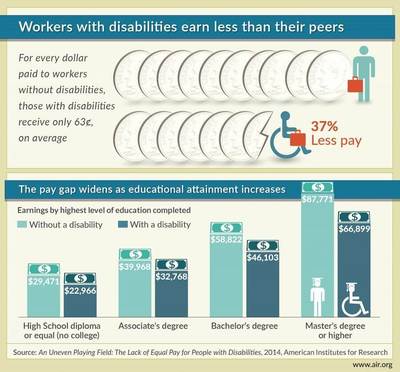People with Disabilities Earn 37% Less on Average
Author: American Institutes for Research
Published: 2014/12/15 - Updated: 2021/02/25
Category Topic: Disability Employment - Academic Publications
Page Content: Synopsis - Introduction - Main
Synopsis: Among workers with high school degree or equivalent, those with disabilities earned on average less than their peers. Experts note that employees with disabilities face economic discrimination similar to what female employees experience
Introduction
Workers with disabilities who have at least a high school education earn 37 percent less on average than their peers without disabilities, a disparity costing federal and state governments up to $31.5 billion in potential tax revenue, finds an American Institutes for Research (AIR) analysis.
Main Content
Earnings disparities increase with higher educational attainment. Among workers with a high school degree or the equivalent, those with disabilities earned on average $6,505 less than their peers in 2011. The gap widens to nearly $21,000 on average among those with a master's or more advanced degree.
AIR experts note that employees with disabilities face economic discrimination similar to what female employees experience; they get 37 percent less pay compared with 35 percent for women.

"Although non-discriminatory compensation is protected through the Civil Rights, Americans with Disabilities, and Rehabilitation Acts, our results show that earnings inequalities are gaping," said AIR author Michelle Yin. Co-author Dahlia Shaewitz adds: "Education and employment are not enough. Equal pay is key to keeping people with disabilities economically independent and out of poverty."
State trends mirror national trends. For employees with a high school diploma or its equivalent, the highest average income inequalities are observed in:
- Vermont ($12,700)
- Connecticut ($12,000)
- Iowa ($10,000)
Among those with a bachelor's degree, the greatest disparities are in:
- Washington, D.C. ($20,000)
- Minnesota ($18,000)
- Washington ($17,000)
At the master's and higher level, the states with the largest gaps are:
- Nevada ($38,700)
- Connecticut ($35,500)
- Hawaii ($33,800)
These trends are reversed in some states, but only in specific educational levels. For example, some workers with disabilities earn more than their peers in the following states:
- Some college education: North Dakota ($9,000), Mississippi ($2,000) and Rhode Island ($2,000).
- Associate's: Utah ($6,500), Wyoming ($1,500) and New Jersey ($1,000).
- Bachelor's: Wyoming ($6,000), New Hampshire ($4,500) and Alaska ($2,500).
- Master's or more advanced: South Dakota ($16,000), Utah ($15,000) and Kentucky ($2,000).
Researchers also looked at broader economic impacts and found that lack of equal pay costs the U.S. economy $141 billion, amounting to about 1 percent of gross domestic product, or about as much as the federal government allocates to education. Loss of tax revenue is another consequence, totaling more than $25 billion for the federal government and more than $6.5 billion for states.
"An Uneven Playing Field: The Lack of Equal Pay for People with Disabilities" used data from the U.S. Census Bureau's 2011 American Community Survey.
Attribution/Source(s): This quality-reviewed publication was selected for publishing by the editors of Disabled World (DW) due to its relevance to the disability community. Originally authored by American Institutes for Research and published on 2014/12/15, this content may have been edited for style, clarity, or brevity.